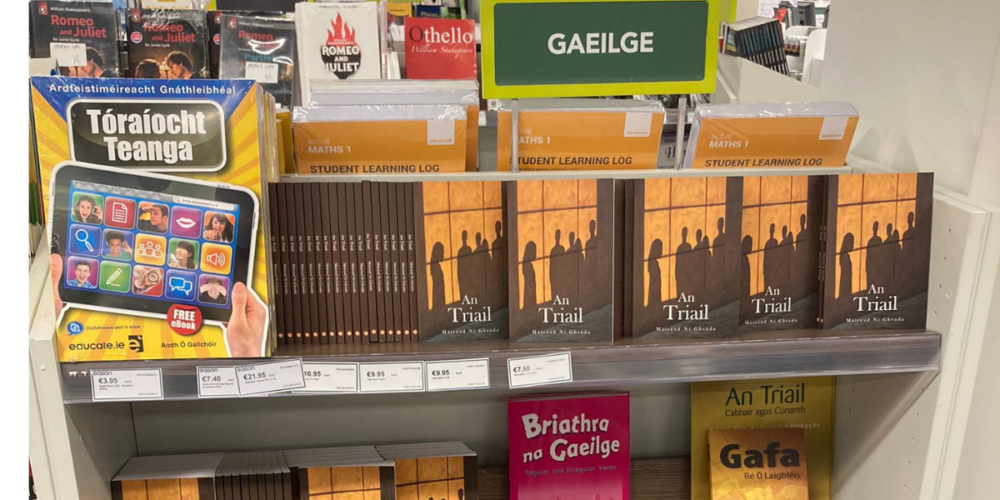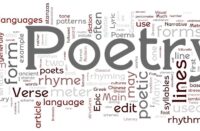There’s a saying on the Isle of Man, “Cha jean oo cosney ping lesh y Ghailick”, which roughly translates as “You won’t make a penny with Manx”.
This perfectly illustrates how every minority language struggles to financially justify its existence.
It’s hard enough to make a living as a writer in any language, let alone one with an inherently smaller readership. This is particularly pronounced in the case of the Irish language when considered in relation to English, even within Ireland – even if 50% of the 73,808 daily Irish speakers bought the same novel, selling 36,404 copies, this would amount to less than, for example, the novel Aisling In The City, from the popular “Aisling” series, managed in 2021 within Ireland alone,
It comes as little surprise then, that publishers are going out of business, such as Cois Life in 2018, and the range of books and writing published is shrinking all of the time. Many Irish-language print publications lost their funding or had it drastically cut after 2008 – Foinse and Lá both closed and even the online Gaelscéal only lasted from 2010 to 2013. There is currently no daily Irish-language newspaper. It has come to be taken as a given amongst even fluent and engaged Irish speakers that, for all the emphasis placed on Irish being spoken in public and on parents raising their children as Irish speakers, books and news will be in English as a matter of course.
Outside of specialist retailers such as An Siopa Leabhair in Dublin or Cló Iar-Chonnacht, the only Irish language books available for sale are often aimed at learners, be they textbooks, surveys of terminology such as the aforementioned recent hits or mandatory Junior and Leaving Certificate writing such as Caisleain Óir or An Triail. Faced with the lack of readily available books, magazines or newspapers, it is little wonder that even fluent and enthusiastic Irish speakers do not find themselves reading in Irish on a regular basis after finishing school.
It could be argued that the internet can help promote Irish-language writing, but only to a very limited degree. Digital media and culture have a much more targeted reach than physical media, and lack the visibility amongst the wider public required to inspire Irish speakers to read in Irish or create new Irish speakers. The current reliance on the internet and specialised bookshops to sustain Irish-language writing places the best efforts of those involved into a ghetto where they is invisible to Anglophones, and receive scant publicity. Only one of the five novels published by Mícheál Ó Laoghaire since 2017 was reviewed in The Irish Times. In the absence of a viable print media culture, the infrastructure to develop a new generation of Irish language writers by exposing readers to a wide range of different writing and topics is absent. This is to say nothing of the lack of the necessary infrastructure to allow journalists, poets and fiction writers to develop their craft by publishing in newspapers, anthologies or magazines over the course of several years before progressing towards more ambitious projects.
This has a major effect on the vitality of the language inside and outside Gaeltacht areas. Within the Gaeltacht, children grow up unable to read the news in Irish and without a sense of the language as a written language. Outside the Gaeltacht, it contributes to a sense the language is irrelevant outside the education system and makes it even harder to sustain Irish-language publishing for want of an interested reading public. It may be one thing that nobody writes in Irish with the expectation of making money from it, but yet another that somebody will write a novel knowing that nobody will ever read it.
This is far from a new problem. Máirtín Ó Cadhain, the most important Irish language fiction writer of the 20th century, failed to publish a follow-up novel to Cré na Cille in his lifetime despite winning several prizes for the manuscript of Athnuachan. Indeed, translators across the world have noted that authors who write in languages other than English are increasingly submitting work in a simplified form of the language devoid of regional variations or idiomatic language to better enable translation into English and access to the international market. With this comes an inevitable move towards topics and themes more easily digestible to the Anglophone reader, much of the local flavour of literature being lost as a result.
This loss of nuance may be deeply unfortunate and symptomatic of wider influences on society In the case of a major global language such as Spanish or French. For a minority language such as Irish, or even one with a relatively small overall speaker base such as Icelandic, this represents a serious sign of the living language being submerged by the torrents of English. When people, particularly younger people, read less and less in Irish, their competency and familiarity with the language fails to develop properly. This tendency has been accelerated by the advent of social media and move towards increasingly online forms of communication – studies have found that even native Irish speakers frequently only use English on major social media platforms, contributing to a shift towards it being more natural for them to speak English to their bilingual friends. When children and teenagers are inundated with English-language media and technology like this, and thereby heavily exposed to Anglo-American culture rather than anything distinctly Irish, let alone Gaelic, it can hardly be a surprise that the Irish language (as a living language) fails to become part of their identities. Success stories such as TG4, An Cailín Ciúin or the rappers Kneecap hardly register with young people growing up in Ireland compared to the sheer volume of Anglophone content consumed.
This process of language shift accelerated by media has been occurring on a much larger scale in Iceland, where the internet has led to the digital minoritisation of the Icelandic language even amongst native speakers in recent years. The result is that children growing up in Iceland, as in Ireland’s remaining Gaeltacht areas, have a diminishing vocabulary due to not being exposed to new language outside the education system, and an increased sense that the language is useless and irrelevant. Efforts have been made to encourage children to read in Irish, with bestsellers such as Harry Potter and Game of Thrones even having been translated into Irish. This has done little to stop readers instinctively seeking out the English language versions.
Much of the conversation about the Irish language has focused on the survival of Irish as a spoken language and people’s competency in this regard. However, without a viable written language and literary culture, language revival will be necessarily incomplete and stifled by the dominance of English. If even capable Irish speakers are overwhelmingly reading in English and familiar with Anglophone media, it follows that they will be more comfortable writing in English even with their own family. This is to say nothing of the implications of this for the development of a new generation of Irish-language writers, or even the possibility of a genuinely separate Irish-language cultural identity. Can it be any surprise that young people growing up in the Gaeltacht find little to connect with within the Irish language, when even our Anglophone media and culture are almost totally preoccupied with British and American topics and conversations, and a neurotic obsessions with defining “Irishness” in relation to them? This is to say nothing of the heavy reliance on syndicated programming by Irish TV stations, newspapers and even radio stations. The result is a cultural conversation awash with Anglo-American rather than Irish reference points.
Indeed, the pressure to create work lacking in regional context to better attract an international readership has been mirrored in English-language writing in Ireland. Irish literature in English has increasingly come to resemble a suburb of the wider Anglo-American publishing world, with author Chris Beausang observing that nearly all of the agencies representing a sample of Irish-based authors were British or American.
An Irish identity developed through English in the 21st century cannot but be more influenced by external forms than anything specific to our own social and historical context. This trend is only likely to get worse, as the processes of cultural domination manifested by imported media are further entrenched by time and technological penetration into people’s daily lives. To counter-act this, Irish-language writing should be embraced to help develop an Irish cultural representation and imagination which can reflect wider influence without being absorbed by wider forces. Harry Potter as Gaeilge may have done little to reverse language shift and cultural colonisation, but a culture of original and relevant Irish-language writing can.
The limited readership for written Irish language material reflects the status of a language many in Ireland can speak to some degree, but neglect to actually do so. If Irish is to have a secondary status to English across the country at large, it follows that the means by which a separate Irish-language conversation would exist are underdeveloped. Why write in your second language, regardless of how well you can speak it, if everyone reading it can speak English anyway? The result of this, as diagnosed by Tomás Mac Siomóin, is that an Irish-language culture genuinely independent from the Anglophone one hasn’t been able to develop fully, limiting the relevance and vitality of the living language. A truly effective Irish-language revival would be rooted in the creation of small, intensely involved networks and communities which embrace the Irish language as a subculture with its own media and cultural scenes, like the LGBT community.
Many of the most effective language revival efforts, such as Na Gaeil Óga, Bóthar Seoighe and even something relatively simple like the Pop-Up Gaeltacht model have demonstrated this by focusing entirely on creating a separate Irish-language space to realise the minority’s potential. What these efforts have in common is a basis in activity from the bottom-up rather than mere “recognition” or “support” – by being inherently participatory, these do a lot to realise Irish as a living language in different areas of life.
Applying these ideas to writing and publishing would therefore mean creating a bottom-up writing scene in which readers and writers are heavily engaged in the cross-pollination of new ideas to exist alongside the work of more established writers. Those involved can learn what can be done to finance and distribute their work from other subcultures to help create a genuinely independent conversation and set of ideas by examining other models of radical media.
It could be argued that this amounts to a generation of writers sacrificing their commercial prospects to make a political point. Yet innovation and genuinely new cultural ideas can only truly thrive when supported and developed far from the mainstream with the margin for failure only a supportive community can provide.
It’s also easily forgotten that every major cultural advance for the Irish language has only come from grassroots activism and a strong DIY ethic, be it the origins of Raidio na Gaeltachta in the pirate station Raidio Saor Connemara, the establishment of TG4 following TV licence fee protests and pirate TV programming in the early 1990s or the efforts of Bob Quinn to make the first feature-length Irish-language films in Connemara in the 1970s. When Irish speakers are passive, the language slips further from the minds of Bearlóirí and comes to seen irrelevant to children growing up in the Gaeltacht. When Irish speakers take action, the language comes alive and can’t be ignored.
What would this DIY ethic and tradition of independence look like if it were to be applied to addressing the current crisis facing written Irish? Like any effort, it’ll only be determined through trial and error over the course of several years. There is one clear rule that must guide this effort, just as it has any effective revival effort down the years:
Na habair é, dean é!






